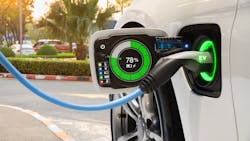More EVs, More Charging Demands: How Grid Operators Can Manage
It is predicted that approximately 30% of all new cars sold in the U.S. in 2030 will be EVs, compared to 3.4% in 2021. This transition from gasoline and diesel to electricity will lower driving costs and reduce greenhouse gas (GHG) emissions. However, the electric infrastructure in place today will need to be managed to accommodate this net load growth while minimizing the costs and impact of EVs.
New residential home construction in the U.S. commonly uses a 100-amp or 200-amp electric distribution panel to supply HVAC, electric ranges, fans, pool pumps, lighting and other electrical equipment. While the number of homes supplied by a single utility distribution transformer varies, the utility typically provides a transformer that is somewhat smaller than the total service rating. This has been possible due to load diversity, where customers are not using all appliances and other loads at the exact same time. Of course, utilities cannot control individual customer behavior. Unrestricted and unpredictable activity, such as what might occur when multiple loads of EV charging come online on the same transformer, creates a major challenge to the assumption of load diversity.
How EV charging presents challenges
Home EV chargers typically use 32 to 50 amps. As certain neighborhoods (especially affluent ones) tend to add electric vehicles at a faster rate than others, it is not surprising to see multiple new charging loads on a single transformer, with dozens or hundreds on a distribution feeder. Now, when two or three customers are on a single transformer or 4,000 customers on a feeder arrive home at about the same time each night and plug in their vehicles, individual transformers and entire feeders can be stressed beyond their design ratings.
One way to deal with this is to install larger distribution transformers and resize utility feeder wires and equipment to ensure they can stand up to new load requirements. However, this would result in hundreds of billions of dollars in expenses to ensure the system is robust enough to handle an electric car in every home. This expense would ultimately be covered through increased customer rates, whether they own a car or not. Another solution may be to curtail all chargers on a feeder where loading of the feeder is an issue. This could result in EV owners being unable to travel with confidence due to limited or no certainty on what the charge state of the vehicle battery will be at any given time.
Operators could consider an EV2G program, in which EVs provide their stored battery energy to the grid. In isolation, these programs offer a solution to demand response challenges. However, concerns around battery chemistry, warranties, and replacements as well as the high cost of offering two-way chargers that enable charging and discharging make EV2G programs a less-optimal short-term solution.
Solutions for utilities, operators, and customers
There are other ways to introduce EVs to the grid without rebuilding electric infrastructure. As most feeder loads follow a common varying load size (peak loads in the morning and late afternoons, low or lower loads at other times) a time-of-use rate could encourage people to charge their cars at times that minimize stress on the grid. Utilities can also provide rate-based or payment incentives to encourage EV owners to let them control their charging equipment directly. The EVs can then be utilized to ensure that everyone’s charging requirements are met with minimal impact on the distribution system, transmission, and generators.
Aggregating EV charging into larger demand response (DR) programs can help achieve peak demand reduction and provide other grid services as needed. It’s helpful to think of an EV charging DR program as part of a utility’s larger efforts to manage integration of distributed energy resources (DERs).
Alongside increased adoption of EVs, utilities are facing challenges in managing other behind-the-meter DERs. Bringing more of these assets online and tapping into them as sources of decentralized, decarbonized energy is essential to lowering emissions and mitigating the damage of climate change. However, most current utility systems were not designed to cope with and manage this process.
This is where distributed energy resource management systems (DERMS) are beginning to change the game for grid operators. These intelligent, data-driven, customer-responsive, and flexible control systems can optimize the new grid edge, including diverse loads such as EVs, virtual power plants and solar + storage arrays while also working seamlessly with legacy assets. Through situational awareness, demand response management and load forecasting, DERMS enable operators to better manage EV charging on their grid. These platforms can deliver smarter insights to inform time-of-use rate programs and charging incentives, optimizing the use of these assets for owners and the utility at large.
EVs are promising for the environment and utility systems, even with some hurdles to overcome. As more of these vehicles hit the roads, utility operators must view them as grid assets and seek out ways current systems can switch gears and implement new programs that proactively assess and manage EVs as distributed resources.
Andy Bennett is CEO of mPrest, Inc., a developer of world-leading distributed asset orchestration and optimization software.
About the Author
Andy Bennett
CEO
Andy Bennett is CEO of mPrest, Inc., a developer of world-leading distributed asset orchestration and optimization software.
